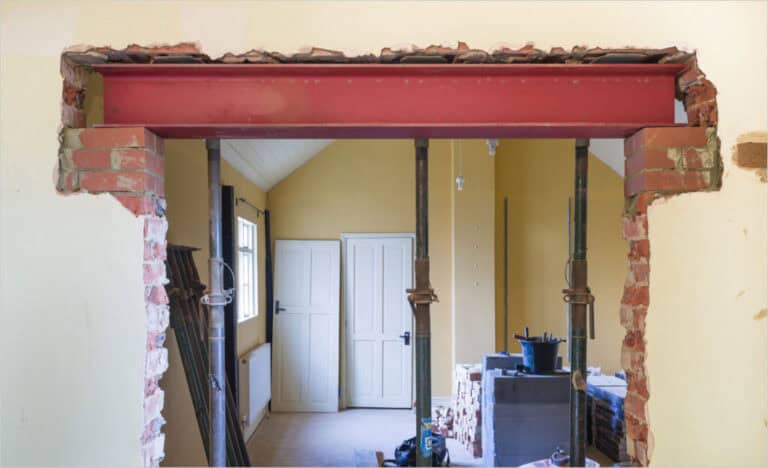Thinking about adding a solar panel patio cover but not sure where to begin? You’re not alone. It’s a smart way to combine outdoor comfort with clean energy—but the process can feel unclear at first.
Imagine a sleek, steel-framed patio that generates electricity, lowers your energy bills, and upgrades your entire outdoor space. It’s not just possible—it’s practical.
Backed by over 20 years of experience in solar-ready structural systems, we’ll walk you through what really matters: structure types, materials, installation, costs, and design options. Whether you’re building it yourself or looking for expert support, this guide will help you plan with confidence.
Ready to see how it all comes together? Let’s get started.
What’s Expected in This Blog:
What Is a Solar Panel Patio Cover and Why Consider One?
A solar panel patio cover is a structure that gives you shade and produces electricity. It’s like a regular patio cover—but with solar panels on top. This way, you make better use of your outdoor space while lowering your energy bills.
Many homeowners are choosing solar patio covers because they combine comfort, functionality, and sustainability. You get a cooler sitting area, and at the same time, your patio becomes a small power station for your home.
If you already enjoy spending time in your backyard or on your patio, this is a smart upgrade. And if you’re planning a new build, starting with a solar-ready design saves time and money down the road.
Besides energy savings, a well-built solar patio cover can:
- Increase your home’s resale value
- Help reduce your carbon footprint
- Give you more control over your energy use
In short, it’s a way to turn your everyday outdoor space into something smarter—with real, long-term value.
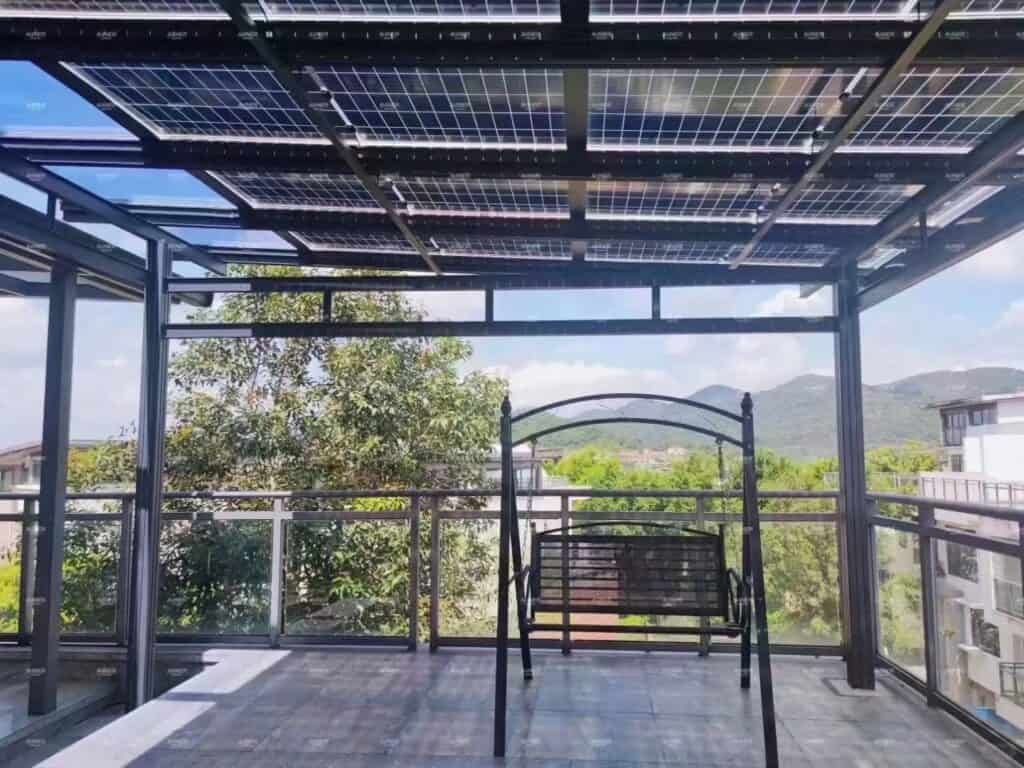
Can I Install Solar Panels on My Existing Patio Cover?
It’s a common question—and a good one. Not every patio cover is ready to handle the weight and function of solar panels. But in many cases, yes, it’s possible. You just need to check a few key things first.
Here’s how to tell if your current patio cover is suitable:
- Is it strong enough?
Solar panels aren’t extremely heavy, but your structure must be load-bearing. Lightweight wood or aluminum frames may not support the panels safely—especially in areas with wind or snow. - Does it get enough sun?
Orientation matters. South-facing covers work best. If your patio is mostly in the shade or faces the wrong direction, the energy output may not be worth the cost. - What’s the roof surface like?
Solid flat surfaces are easier to mount on. Sloped or decorative designs can make installation harder or require custom mounting brackets.
If your patio passes these checks, that’s great—you may only need a mounting system and a solar installer.
But if your structure isn’t ideal, don’t worry. You still have options:
- Reinforce the existing frame with steel components
- Replace the cover with a purpose-built solar-ready structure
The good news is, many companies (like ours) offer pre-engineered steel frames designed specifically to support solar panels—strong, safe, and easy to assemble.
What Are the Options for Building a Solar Patio Cover?
If you’ve decided to build a solar-ready patio cover, there are three main paths you can take. Each one works—you just need to find the right fit for your budget, skills, and timeline.
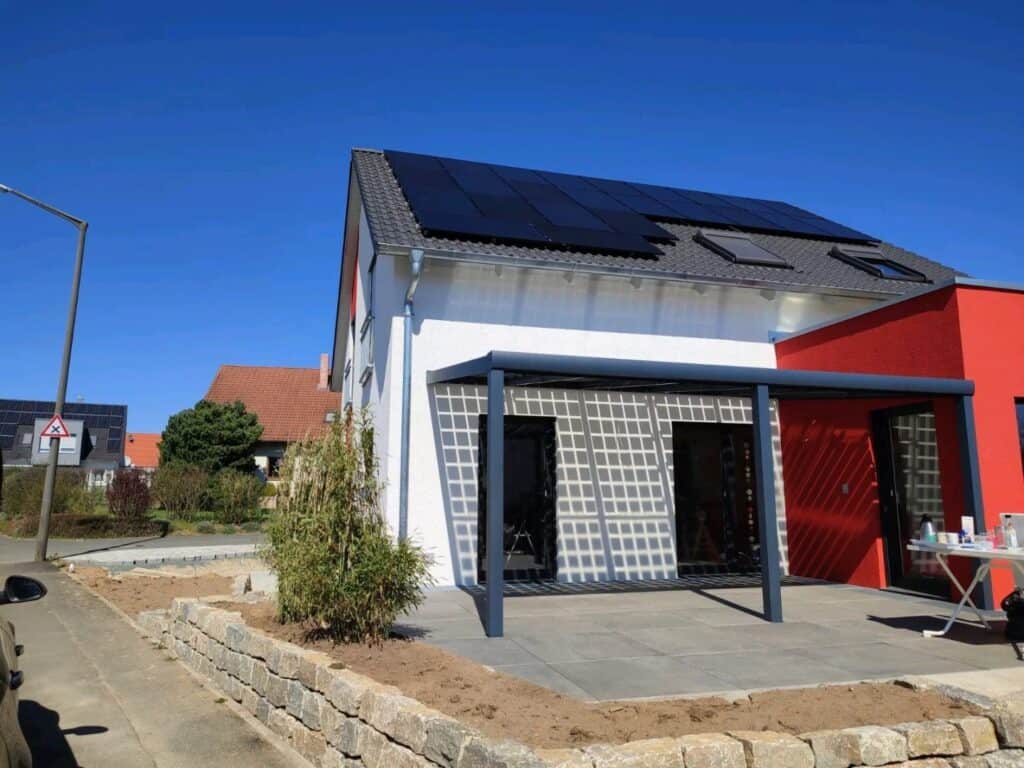
1. Build It Yourself (Custom DIY Approach)
This option gives you full control. You design the structure, choose materials, and handle the installation.
It’s best if you’re experienced with building projects or working with a contractor you trust.
Pros:
- Total freedom in design
- Can be cost-effective if you have the tools and time
Keep in mind:
You’ll need to make sure the structure is strong enough to support solar panels. Engineering help may be required, especially for steel or hybrid frames.
2. Use a Pre-Engineered Solar Patio Kit
These kits come with everything pre-cut and pre-drilled. They’re made to carry solar panels and are often modular in design.
This is ideal if you want something easier and faster to assemble.
Pros:
- Faster installation
- Less design guesswork
- Often more reliable structurally
Keep in mind:
Make sure the kit matches your local building codes and solar needs. Some kits may look simple but aren’t built for long-term performance.
3. Order a Custom Steel Structure from a Supplier
This is a smart option if you want something engineered for solar and built to last. Companies like SteelPRO PEB offer steel patio frames tailored to your space, load requirements, and solar layout.
Pros:
- Durable, weather-resistant, solar-ready
- Engineered for your location
- Can be shipped as a ready-to-assemble system
Keep in mind:
This option may cost more upfront than DIY wood builds—but it often saves time and avoids problems later.
No matter which path you choose, the goal is the same: a safe, functional, and solar-compatible patio cover. If you’re not sure which option fits you best, we’re always happy to help you compare and decide.
What Materials Work Best for the Structure?
Choosing the right material for your solar patio frame isn’t just about looks. It affects how long the structure will last, how much weight it can carry, and how much work it needs over time.
Wood is a popular choice for its natural look. It blends well with most home styles and can be customized easily. But it comes with downsides—wood needs regular maintenance, can warp or crack over time, and often isn’t strong enough for solar loads without reinforcement. If you live in a humid or termite-prone area, it may not hold up well in the long run.
Steel is known for its strength and durability. It’s ideal for supporting solar panels, especially in larger setups or in areas with wind or snow. Modern steel structures are corrosion-resistant and can be powder-coated for better aesthetics. They require very little maintenance and are designed to last decades, making them a solid long-term investment.
Aluminum is lightweight and doesn’t rust, which makes it a good option in coastal or wet climates. However, it’s not as strong as steel. In most cases, aluminum frames need extra bracing if used to support solar panels. For small structures, it can work—but for anything more substantial, steel is often the better choice.
To make things clearer, here’s a quick comparison:
| Material | Strength | Lifespan | Maintenance | Solar Suitability |
| Wood | Medium | 10–15 years | High | Needs reinforcement |
| Steel | High | 25+ years | Low | Excellent |
| Aluminum | Low–Medium | 15–20 years | Low | Limited |
If your goal is a structure that supports solar panels safely and lasts for years with minimal upkeep, steel often gives you the best balance.
How Do You Actually Build a Solar Panel Patio Cover?
Building a solar patio cover may sound complex—but when you break it down, it follows a clear set of steps. Whether you’re doing it yourself or hiring help, here’s how the process usually works:

1. Plan Your Layout
Start by deciding where your patio cover will go. Look at how the sun moves across your property and make sure the area gets enough sunlight. Measure the space and think about how big you want the cover to be.
2. Choose or Design the Structure
Pick a frame that fits your space and solar needs. You can use a standard patio kit, a pre-engineered steel frame, or design your own from scratch. Make sure it’s strong enough to hold the weight of solar panels.
3. Prepare the Foundation
A solid base is critical. Depending on your design, you may need concrete footings or ground anchors. Getting this step right ensures your structure is stable and lasts for years.
4. Assemble the Frame
This is the main build phase. Follow the instructions if you’re using a kit. If it’s custom, make sure every part fits as planned. Using steel? Pre-cut and pre-drilled systems can save a lot of time here.
5. Install the Solar Panels
Once the frame is up, place the solar panels on top. Panels are usually mounted with brackets or rails. Tilt angle matters, so follow best practices for your location. Electrical wiring should always be done by a licensed professional.
It’s a manageable process—but it pays to plan carefully. If you’re unsure about any step, especially the structural or electrical parts, talk to a professional or your structure supplier before starting.
How Much Does a Solar Patio Cover Cost?
There’s no single price tag for a solar patio cover. The total cost depends on several factors, including the structure, the solar system, and the installation method. But with a bit of planning, it’s easier than you think to find an option that fits your budget.
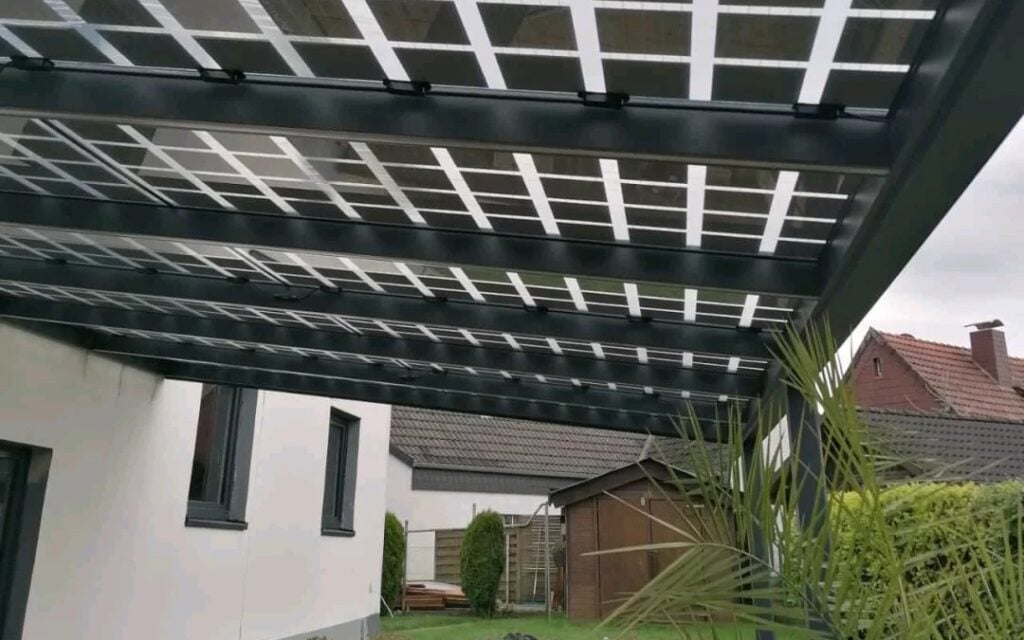
What affects the total cost?
Here are the main elements that shape the final price:
- Structure type and materials
Steel frames cost more upfront than wood, but they last longer and need less upkeep. - Size and complexity
A simple 2-post cover costs less than a custom L-shaped design or a large freestanding unit. - Solar panel system
Costs vary based on panel efficiency, number of panels, and power output. - Labor and permits
If you hire a contractor or need engineering approvals, that adds to the budget.
Rough cost ranges by setup
| Setup Type | Estimated Cost (USD) |
| Basic DIY wood frame + panels | $4,000 – $8,000 |
| Pre-engineered steel kit + panels | $9,000 – $15,000+ |
| Custom steel structure + solar | $12,000 – $20,000+ |
Note: These ranges include both structure and panels, but exact costs depend on your location and system size.
Is it worth the investment?
Many homeowners find that a solar patio cover pays for itself over time. By generating your own electricity, you lower your monthly bills. In sunny areas, the payback period can be as short as 6–8 years, depending on your usage.
Plus, it’s not just about savings—it’s also an upgrade to your home’s value and comfort.
The key is to balance your goals, your budget, and the long-term return. Whether you go simple or custom, there’s a solution that can work for you.
Further Reading:
Are Solar Patio Covers Worth It? Here’s the Real Answer
Do I Need a Permit or Professional Help?
If you’re thinking about building a solar patio cover, this is one question you shouldn’t skip. It may not be the most exciting part—but it can make or break your project.
Permits: Do You Need One?
In many areas, yes. Even if your structure seems simple, adding solar panels means extra weight and electrical components. That usually triggers the need for a building permit, especially if the frame is attached to your home.
Local rules vary, so it’s always best to check with your city or county office before starting. They may ask for structural drawings, load calculations, or stamped documents.
Should You Hire a Professional?
That depends on your setup and your experience. Here’s a simple way to think about it:
- If you’re building a small, freestanding wooden structure and using plug-in solar kits, you might handle it yourself.
- But if you’re working with steel, mounting high-wattage panels, or connecting to your home’s grid, you’ll likely need a licensed contractor—especially for electrical work.
Also, don’t overlook the value of an engineer or structural supplier who understands local codes. They can make sure your design is not just strong—but also compliant.
Can It Be Stylish Too?
Absolutely. Just because it’s solar doesn’t mean it has to look industrial. A well-designed solar patio cover can be both functional and beautiful—something that complements your outdoor space, not clashes with it.
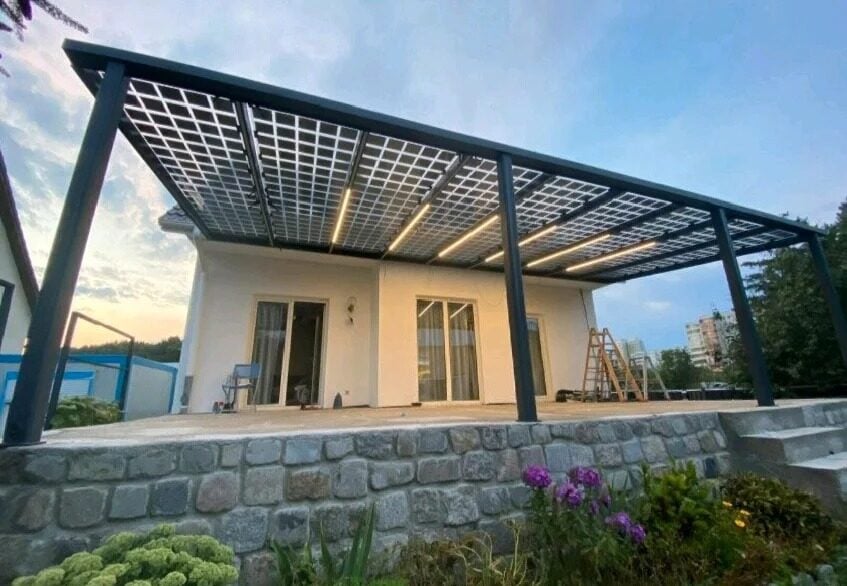
Think clean steel lines paired with wood accents. Or a minimalist flat roof that matches your modern home. Some designs look like high-end pergolas, with hidden wiring and sleek solar panels that blend right into the roofline.
You can also add finishing touches:
- Powder-coated surfaces in colors that match your home
- Built-in LED lighting
- Decorative beam profiles or panel trims
If you start with the right structure, style becomes part of the build—not just an afterthought. Steel, for example, can be both strong and visually elegant. It offers clean geometry, slim profiles, and plenty of room for creative expression.
At SteelPRO PEB, we’ve seen clients turn simple solar covers into design highlights. If you have a vision in mind, chances are we can help bring it to life.
Where Can I Find a Trusted Structure Supplier?
At this point, you may be asking: who can help me bring this project to life? Choosing the right structure supplier is key to making your solar patio cover safe, reliable, and built to last.
Here’s what to look for in a supplier—and how SteelPRO PEB is built for the job:
- Engineering Expertise
Your structure needs to support solar panels, resist wind and snow loads, and meet local codes. SteelPRO PEB offers custom structural design backed by real-world engineering—complete with stamped drawings, 2D/3D models, and load calculations tailored to your site. - Purpose-Built for Solar
Unlike general-purpose patio kits, our systems are specifically engineered for solar integration. That means optimized tilt angles, cable management, and true long-term performance under outdoor conditions. - Precision Manufacturing
We fabricate all frames in-house using HDG steel, CNC welding, laser cutting, and powder coating. Every project goes through full-process quality control—so what you get is strong, accurate, and built to last. - Reliable Global Delivery
From secure packaging to international shipping, we deliver to over 30 countries worldwide. Each kit includes detailed manuals, instructional videos, and remote installation support. For large projects, we even offer on-site guidance.
SteelPRO PEB has 1000+ successful projects for homes, cafés, outdoor lounges, and commercial patios across North America, Europe, Southeast Asia, and beyond.
Planning your own solar patio cover? Let’s talk. Share your ideas, and we’ll help you make it real—with structural confidence and design clarity.

